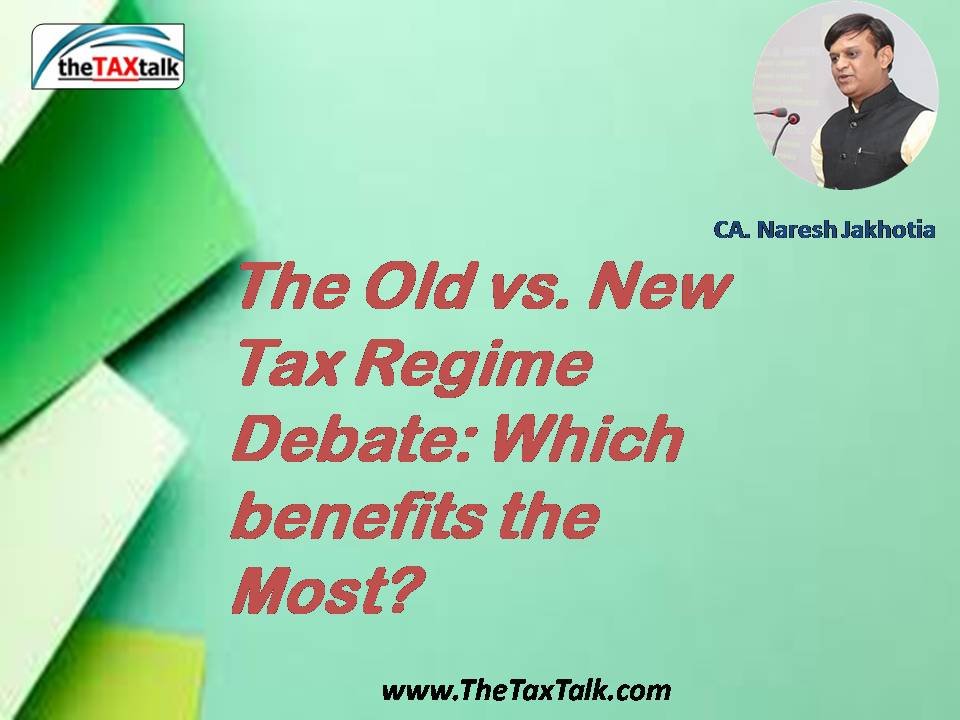![]()
The Old vs. New Tax Regime Debate: Which benefits the Most?
In the last issue of The Tax Talk, we had discussed the new tax regime & its key feature. The old tax regime allows taxpayers to enjoy a plethora of exemptions and deductions which reduces the taxable income. Despite this, the new tax regime may be beneficial in many cases as it has a separate tax rate & slab. The tax rate and slab under the new tax regime is Nil for income up to Rs. 3 Lakh, 5% for income between Rs. 3 to 6 Lakh, 10% for income between Rs. 6 to 9 Lakh, 15% for income between Rs. 9 to 12 Lakh, 20% for income between Rs. 12 to 15 Lakh, 30% for income above Rs. 15 Lakh. Under the old tax regime, the tax rate is 5% for income between Rs. 2.50 to 5 Lakh, 20% for income between Rs. 5 to 10 Lakh & 30% for income above Rs. 10 Lakh. The most appealing part of the new tax regime is that it offers a higher tax rebate under section 87A which has been increased from Rs. 12,500/- to Rs. 25,000/-. As a result of this, all individuals with income up to Rs. 7 will not be required to pay a single penny under the new tax regime. Apart from this, the benefit of standard deduction is now extended to the salaried taxpayer opting for the new tax regime. Further, reduction in the highest surcharge rate from 37% to 25% has made the new tax regime more beneficial for HNI.
The most important question raised by the taxpayers are;
- Whether it is advisable to opt for a new tax regime even if the person has invested in LIC/PPF/Mediclaim policies or have availed the housing loan.
- Whether the basic exemption limit is Rs. 7 Lakh for the taxpayers who have opted for a new tax regime?
Let us discuss it:
- Whether the old regime could still be better?
Both regimes have their own sets of pros and cons. The choice of the tax regime would necessarily depend on:
a) Income Slab: Tax regime choice would be dependent on the income slab applicable to individuals.
b) Exemption & Deductions: The extent of available exemptions and deductions plays a crucial role in the decision-making process
c) Alternate Investment option: Consideration of alternative investment options and their returns may influence the decision.
d) Financial Goals: Short-term and long-term financial goals are equally important while making the investment & claiming deduction.
While the new tax regime has a simplified tax structure, it is advisable to calculate the tax liability under both regimes before making a decision
- Even though there are numerous benefits & motivation now for the taxpayers under the new tax regime, still the old regime could be better in some cases.
- The detailed chart hereunder illustrates the minimum amount of exemptions/deductions (such as LIC/PPF, Mediclaim, housing loan interest) above which the old tax regime may be more advantageous. Taxpayers can work out their tax outgo to decide which regime is better.
| TAX LIABILITY UNDER NEW TAX REGIME
FROM FY 2023-24 |
||||||||||
| Gross Total Income | Tax | Rebate U/s 87A | Cess | Total Tax | Tax under the Old Regime …. | Minimum amount of
Exemption/ Deduction after which the old Regime will be better |
||||
| I | IV | V | VI | VII | VIII | VIII | ||||
| 500,000 | 10,000 | 10,000 | – | – | – | – | ||||
| 600,000 | 15,000 | 15,000 | – | – | 33,800 | 100,000 | ||||
| 650,000 | 20,000 | 20,000 | – | – | 44,200 | 150,000 | ||||
| 700,000 | 25,000 | 25,000 | – | – | 54,600 | 200,000 | ||||
| 800,000 | 35,000 | – | 1,400 | 36,400 | 75,400 | 187,500 | ||||
| 900,000 | 45,000 | – | 1,800 | 46,800 | 96,200 | 237,505 | ||||
| 1,000,000 | 60,000 | – | 2,400 | 62,400 | 117,000 | 262,504 | ||||
| 1,100,000 | 75,000 | – | 3,000 | 78,000 | 148,200 | 287,503 | ||||
| 1,200,000 | 90,000 | – | 3,600 | 93,600 | 179,400 | 312,502 | ||||
| 1,300,000 | 110,000 | – | 4,400 | 114,400 | 210,600 | 312,500 | ||||
| 1,400,000 | 130,000 | – | 5,200 | 135,200 | 241,800 | 341,666 | ||||
| 1,500,000 | 150,000 | – | 6,000 | 156,000 | 273,000 | 375,000 | ||||
| 1,600,000 | 180,000 | – | 7,200 | 187,200 | 304,200 | 375,000 | ||||
| 1,700,000 | 210,000 | – | 8,400 | 218,400 | 335,400 | 375,000 | ||||
| 1,800,000 | 240,000 | – | 9,600 | 249,600 | 366,600 | 375,000 | ||||
| 1,900,000 | 270,000 | – | 10,800 | 280,800 | 397,800 | 375,000 | ||||
| 2,000,000 | 300,000 | – | 12,000 | 312,000 | 429,000 | 375,000 | ||||
| 2,100,000 | 330,000 | – | 13,200 | 343,200 | 460,200 | 375,000 | ||||
The copy of the order is as under:

